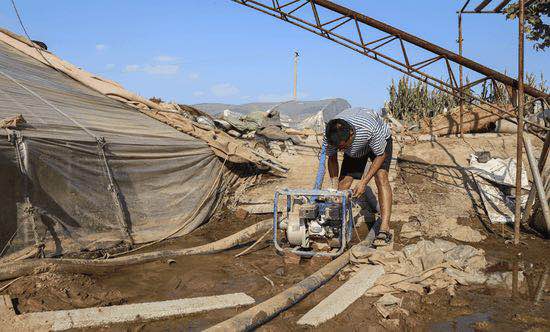


A farmer fuels a pump to drain water from his greenhouse in Shouguang, Shandong Province, on Sunday. (ZHANG YANAN/FOR CHINA DAILY)
Farmers grapple with losses; some blame faulty early management
Seven days after flooding that typically occurs only once in several decades inundated farm houses and drowned large numbers of livestock, water up to 1 meter deep persists in Nanzhaike village, in Shouguang, Shandong Province.
Drones dropping antiseptic solutions hum above the village-which has been sealed off-giving the whole place a pungent aroma.
Health workers dressed in white work around the clock to drain the remaining water and to move animal carcasses to be buried in lime-filled pits up to 6 meters deep.
Homeless villagers are taking shelter at a primary school 4 kilometers away, with relief supplies-including bottled water, instant noodles and sausages-piled along the walls.
"Two hundred and sixty pigs and 26,000 ducks have been killed in Nanzhaike alone, with houses uninhabitable for the time being," said Sun Chengyu, an official of Yangkou, whose jurisdiction includes the village.
Nanzhaike is among the many areas in Shouguang-one of China's biggest vegetable bases-that are making a gradual recovery after Typhoon Rumbia and Tropical Storm Yagi. Health workers were mobilized to minimize the risk of postflood epidemics.
The storms, which began to hit the province on Aug 18, had left 14 dead and two missing in Weifang as of Sunday, according to the city government. Weifang is a prefecture-level city that oversees Shouguang.
The direct economic damage is estimated at more than 10 billion yuan ($1.4 billion). The vegetable capital was among the most severely hit.
According to the local disease prevention and control authority, the first round of disinfection work has been finished in Shouguang, except for a few villages where draining is still underway, such as in Nanzhaike. Health workers have been sent door to door to exterminate mosquitoes and flies.
Several towns including Yingli, Shangkou and Jitai have finished the work, allowing displaced residents to gradually head home, the authorities said.
Electricity, traffic and telecommunications have also been restored in most of Weifang. Flood relief supplies including 23,200 quilts, 3,200 tents and 3,400 folding beds were in place as of Friday, according to Weifang's civil affairs authority.
Despite relief efforts, vegetable farmers have voiced concerns over their losses. Liu Jingyi, from Shouguang's Liujiayaohe village, said it will take another few days to drain his two greenhouses, which were built last year and cost him 150,000 yuan.
"I have not bought any agricultural insurance, and I have no idea what I should do now," he said.
Many have blamed the disaster on a failure to discharge water in advance in response to flood warnings. Too much water discharged from three reservoirs in the upper sections of the Mihe River left limited time for livestock to be evacuated, they say.
The Mihe flows down from Shandong's Linqu county to the Bohai Sea at Shouguang.
Local authorities said they underestimated Rumbia's might, adding that the water-if not discharged-could have bust dams and caused even greater damage.
Several cities in the coastal province have seen a decline in rainfall over the past few years, and some rivers have dried up. It has become common for farmers to build homes, greenhouses and animal farms in dry riverbeds, according to a report by Science and Technology Daily.
The Flood Control Law forbids erecting buildings, dumping waste or planting trees in the flood zone.
 Fire brigade in Shanghai holds group wedding
Fire brigade in Shanghai holds group wedding Tourists enjoy ice sculptures in Datan Town, north China
Tourists enjoy ice sculptures in Datan Town, north China Sunset scenery of Dayan Pagoda in Xi'an
Sunset scenery of Dayan Pagoda in Xi'an Tourists have fun at scenic spot in Nanlong Town, NW China
Tourists have fun at scenic spot in Nanlong Town, NW China Harbin attracts tourists by making best use of ice in winter
Harbin attracts tourists by making best use of ice in winter In pics: FIS Alpine Ski Women's World Cup Slalom
In pics: FIS Alpine Ski Women's World Cup Slalom Black-necked cranes rest at reservoir in Lhunzhub County, Lhasa
Black-necked cranes rest at reservoir in Lhunzhub County, Lhasa China's FAST telescope will be available to foreign scientists in April
China's FAST telescope will be available to foreign scientists in April "She power" plays indispensable role in poverty alleviation
"She power" plays indispensable role in poverty alleviation Top 10 world news events of People's Daily in 2020
Top 10 world news events of People's Daily in 2020 Top 10 China news events of People's Daily in 2020
Top 10 China news events of People's Daily in 2020 Top 10 media buzzwords of 2020
Top 10 media buzzwords of 2020 Year-ender:10 major tourism stories of 2020
Year-ender:10 major tourism stories of 2020 No interference in Venezuelan issues
No interference in Venezuelan issues
 Biz prepares for trade spat
Biz prepares for trade spat
 Broadcasting Continent
Broadcasting Continent Australia wins Chinese CEOs as US loses
Australia wins Chinese CEOs as US loses